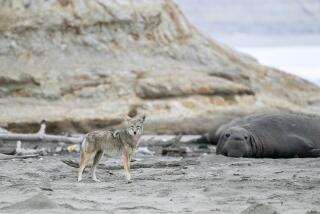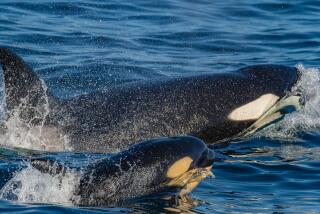Basics of Life : Elephant Seal’s Annual Ritual of Sex, Violence Displays the Interaction of Fighting and Fathering
- Share via
ANO NUEVO STATE RESERVE, Calif. — About 100,000 northern elephant seals off the Pacific Coast today are all descendants of a single colony of fewer than 100 that survived the slaughter of 19th-Century hunters. The creatures possess an overwhelming sex drive, which helped replenish their colony after hunting was banned.
It’s an annual ritual of sex and violence on the coast of California.
Once nearly extinct, about 1,800 northern elephant seal cows and 600 to 700 bulls converge to fight, breed and nurse a new generation of 1,800 pups on the beaches, sand dunes and offshore island at Ano Nuevo State Reserve, 50 miles southeast of San Francisco.
From December to March the reserve is a major rookery in the elephant seals’ habitat, which ranges from off San Francisco to central Baja California.
On a typical day, a small elephant seal cow is seen desperately worming her way across the sand toward the Pacific Ocean, pursued by EPO3, a 2-ton male.
Harem of 50
The 16-foot-long bull, which dominates a harem of about 50 cows, quickly overtakes the female, ignoring her growls of protest as he mates.
Two younger bulls sneaking toward the nearby harem are chased away by EPO3, who rears up and trumpets a belligerent warning. The invaders do the same but flee nonetheless.
Later, two other bulls engage in battle, biting and trumpeting for 10 minutes. They are drenched with blood as they fight for access to cows and a chance to pass their characteristics to future generations.
“Sex and violence--it’s the basics of life,” said Burney Le Boeuf, a biologist at UC Santa Cruz who has been studying the seals for two decades for the government.
“If there’s any doubt reproduction is fundamental to all life processes, how an animal behaves and what it looks like, then go to Ano Nuevo and look at elephant seals breeding.”
Le Boeuf believes that the seals’ need to conserve energy for reproduction accounts for their ability to fast for 90 days, hold their breath for up to 48 minutes while under water, and repeatedly dive to depths of 3,000 feet or more where no other marine mammals venture, except possibly beaked and sperm whales.
Can Slow Metabolism
By diving to such depths, pregnant seal cows slow their metabolism as they feed on a rich supply of squid, skates, rays and ratfish, Le Boeuf’s studies suggest. They expend minimal energy so they can be in prime condition to deliver and nurse their pups.
Only the biggest and fiercest bull seals get to sire offspring. So natural selection has gradually made the bulls extremely aggressive and given them tools to scare other bulls: elephant-like snouts, the ability to trumpet, and body weights three to seven times that of the cows.
“The bigger the male, the better the fighter, and the better the fighter, the better the lover,” Le Boeuf said. “You don’t get to be a good lover (or a father) unless you’re a good fighter.”
The seals’ fearless behavior almost caused their demise. They were easy targets for 19th-Century hunters who sought their blubber for tanning, lamp fuel, machinery lubricant, and making margarine, paint, clothing and soap.
Nearly Extinct in 1892
Unlike South America’s more abundant southern elephant seals, northern elephant seals were nearly extinct by 1892, with fewer than 100 surviving on Isla de Guadelupe, 150 miles off Baja’s west coast.
All 100,000 northern elephant seals alive today descended from that colony, which was given Mexican government protection in 1922.
Male elephant seals reach 16 feet in length and weigh up to 4,000 pounds. Females reach 9 feet and 1,600 pounds. Their life span is about 14 years for males, 16 to 17 years for females.
Le Boeuf said males will mate about 10 times a day.
“They will try to mate anything--dead or pregnant females, other males, even pups,” he said. “They’re so indiscriminate it’s amazing.
“Our most famous seal was Adrian. We estimate he inseminated over 250 different females in his lifetime. It’s a record.”
Because a dominant male ruthlessly fights and sometimes kills weaker bulls intruding on his harem, 30% to 80% of the males never mate.
Le Boeuf, a 53-year-old Louisianian, compared the scene to a sleazy singles bar where “the female starts the fight, all the males fight, and she goes off with the winner.”
“The females almost always protest,” said Teri Pate, 22, one of Le Boeuf’s students. “I get pleasure whenever a female gets a good bite.”
Because fight they must to father pups, bulls evolved their threatening big snouts, shaped like stubby elephant trunks.
“It’s like antlers on a stag,” Le Boeuf said.
On land, the seals hold their breath up to 25 minutes during naps, which allows the bulls to save energy for fighting and mating and the cows to conserve energy for nursing.
Because the bulls must guard their harems, they fast during the 3-month breeding season, deriving energy and water from blubber. The cows also fast during the 34 days they spend on land to deliver their pups and nurse them with some of nature’s richest milk.
“A pup goes from about 85 pounds at birth to 300 pounds at weaning in four weeks,” Le Boeuf said. “They’ve literally been injected with fat from the mother.” The cows lose about 40% of their weight during the four weeks of nursing.
As they finish nursing, the cows breed, becoming pregnant again. Then they swim to sea for 72 days, leaving weaned pups on the beach to fend for themselves and learn to swim and dive. Five percent to 30% of the pups do not survive.
In his studies, Le Boeuf has glued cylinder-shaped, time-depth recorders to the backs of 20 females. Each $2,600, battery-operated recorder contains a pressure sensor, a light-emitting diode and film to measure the time and depth of each dive.
The studies showed that pregnant cows spend 85% of their time under water and only a few minutes at the surface between dives. They dive to an average of 1,300 to 2,100 feet and sometimes to 3,000 feet, nearly twice as deep as any other seal species. The pressure, 90 times greater than at the surface, would kill humans.
Le Boeuf theorizes that the seals can stay submerged so long because they conserve oxygen by slowing their heart rate, lowering metabolism and temperature, and reducing blood flow to organs like the liver and kidneys. They may also sleep while diving.
This allows the seals to escape to depths uninhabited by their only predator, great white sharks. They eat a rich food supply with little competition. Weight is gained rapidly to prepare for nursing the pups they will deliver the next December.
2-Pound Gain Per Day
By weighing cows after they mate and again when they return to molt, or shed fur, 72 days later, Le Boeuf found that each cow gained 2 pounds daily at sea.
Le Boeuf, who started out studying hormones and social behavior in rats and dogs, first watched seals fighting to establish their pecking order during a visit to Ano Nuevo in 1968.
He later began weighing seals and studying their blood and metabolism. He used hydrogen peroxide and hair dye to mark names on their fur--names like E.T., FBI, CIA, Yin and Yang--so he could follow individuals for their lifetimes.
Le Boeuf said seals are easy to study because they do everything in the open and do not fear humans.
“We get insights into other animals and our own lives by studying one animal in depth,” he said. “We’re all products of natural selection. The mating strategies humans followed--our ancestors before civilization--were probably not much different than mating strategies in elephant seals.”
More to Read
Sign up for Essential California
The most important California stories and recommendations in your inbox every morning.
You may occasionally receive promotional content from the Los Angeles Times.













